Anti-Money Laundering Responsibilities and Bank Actions in Malaysia
VerifiedAdded on 2023/01/13
|12
|4257
|32
Report
AI Summary
This report delves into the Anti-Money Laundering (AML) responsibilities of banks in Malaysia, focusing on reporting obligations and actions taken in response to potential financial crimes. The report examines the legal framework, including the Anti-Money Laundering, Anti-Terrorism Financing and Proceeds of Unlawful Activities Act (AMLA) 2001, and outlines the requirements for banks to implement AML/CFT risk management, perform customer due diligence, maintain records, and report suspicious transactions. It analyzes a specific scenario involving a Money Service Business (MSB) suspected of money laundering through its accounts, evaluating the risks involved, grounds for suspicion, and potential actions the bank should take, such as freezing accounts and liaising with authorities. The report also includes real-life case studies of money laundering in Malaysia and emphasizes the relationship between the compliance team and the bank's business divisions. The report highlights the importance of compliance with AML regulations to prevent financial crimes and protect the integrity of the financial system.
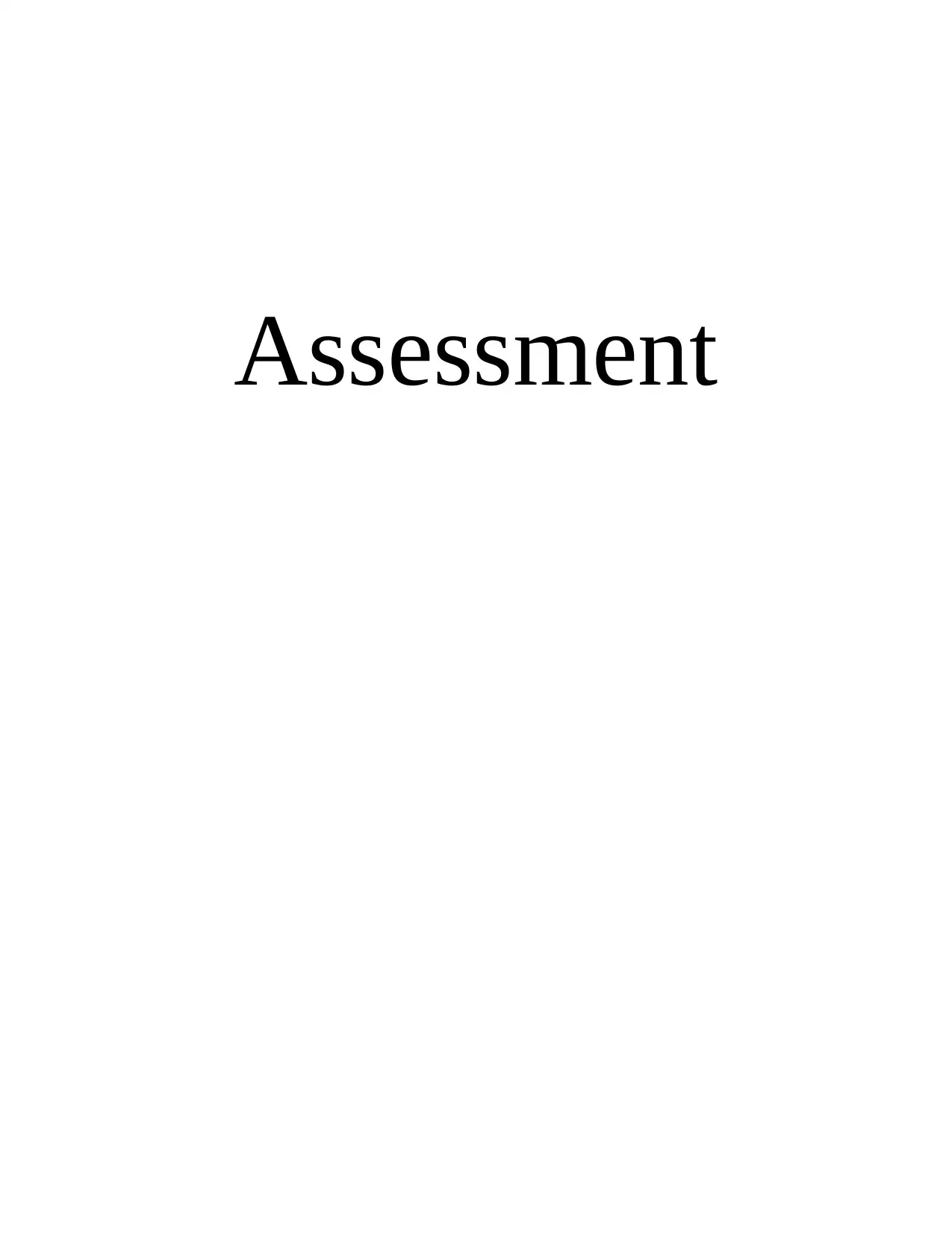
Assessment
Paraphrase This Document
Need a fresh take? Get an instant paraphrase of this document with our AI Paraphraser
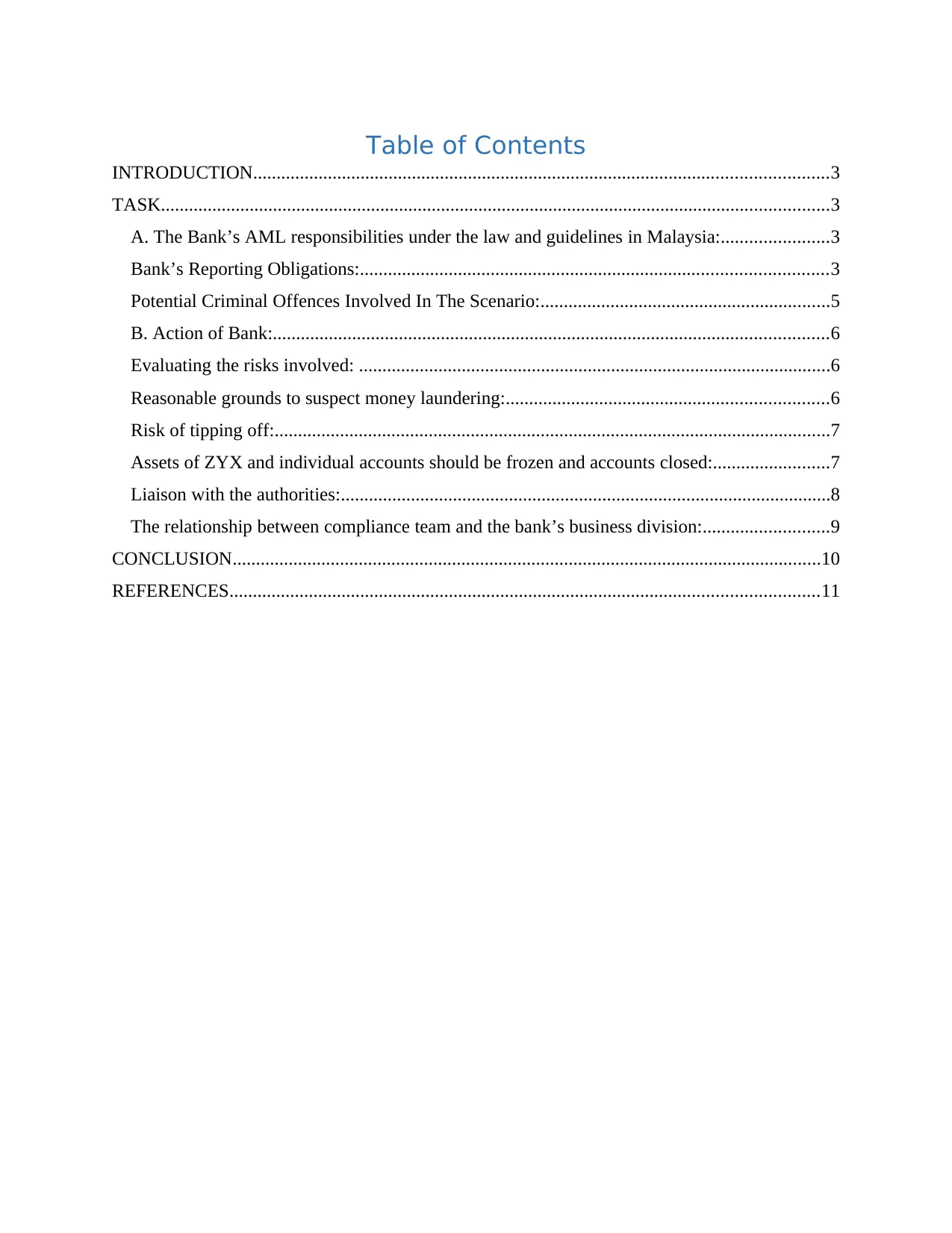
Table of Contents
INTRODUCTION...........................................................................................................................3
TASK...............................................................................................................................................3
A. The Bank’s AML responsibilities under the law and guidelines in Malaysia:.......................3
Bank’s Reporting Obligations:....................................................................................................3
Potential Criminal Offences Involved In The Scenario:..............................................................5
B. Action of Bank:.......................................................................................................................6
Evaluating the risks involved: .....................................................................................................6
Reasonable grounds to suspect money laundering:.....................................................................6
Risk of tipping off:.......................................................................................................................7
Assets of ZYX and individual accounts should be frozen and accounts closed:.........................7
Liaison with the authorities:.........................................................................................................8
The relationship between compliance team and the bank’s business division:...........................9
CONCLUSION..............................................................................................................................10
REFERENCES..............................................................................................................................11
INTRODUCTION...........................................................................................................................3
TASK...............................................................................................................................................3
A. The Bank’s AML responsibilities under the law and guidelines in Malaysia:.......................3
Bank’s Reporting Obligations:....................................................................................................3
Potential Criminal Offences Involved In The Scenario:..............................................................5
B. Action of Bank:.......................................................................................................................6
Evaluating the risks involved: .....................................................................................................6
Reasonable grounds to suspect money laundering:.....................................................................6
Risk of tipping off:.......................................................................................................................7
Assets of ZYX and individual accounts should be frozen and accounts closed:.........................7
Liaison with the authorities:.........................................................................................................8
The relationship between compliance team and the bank’s business division:...........................9
CONCLUSION..............................................................................................................................10
REFERENCES..............................................................................................................................11
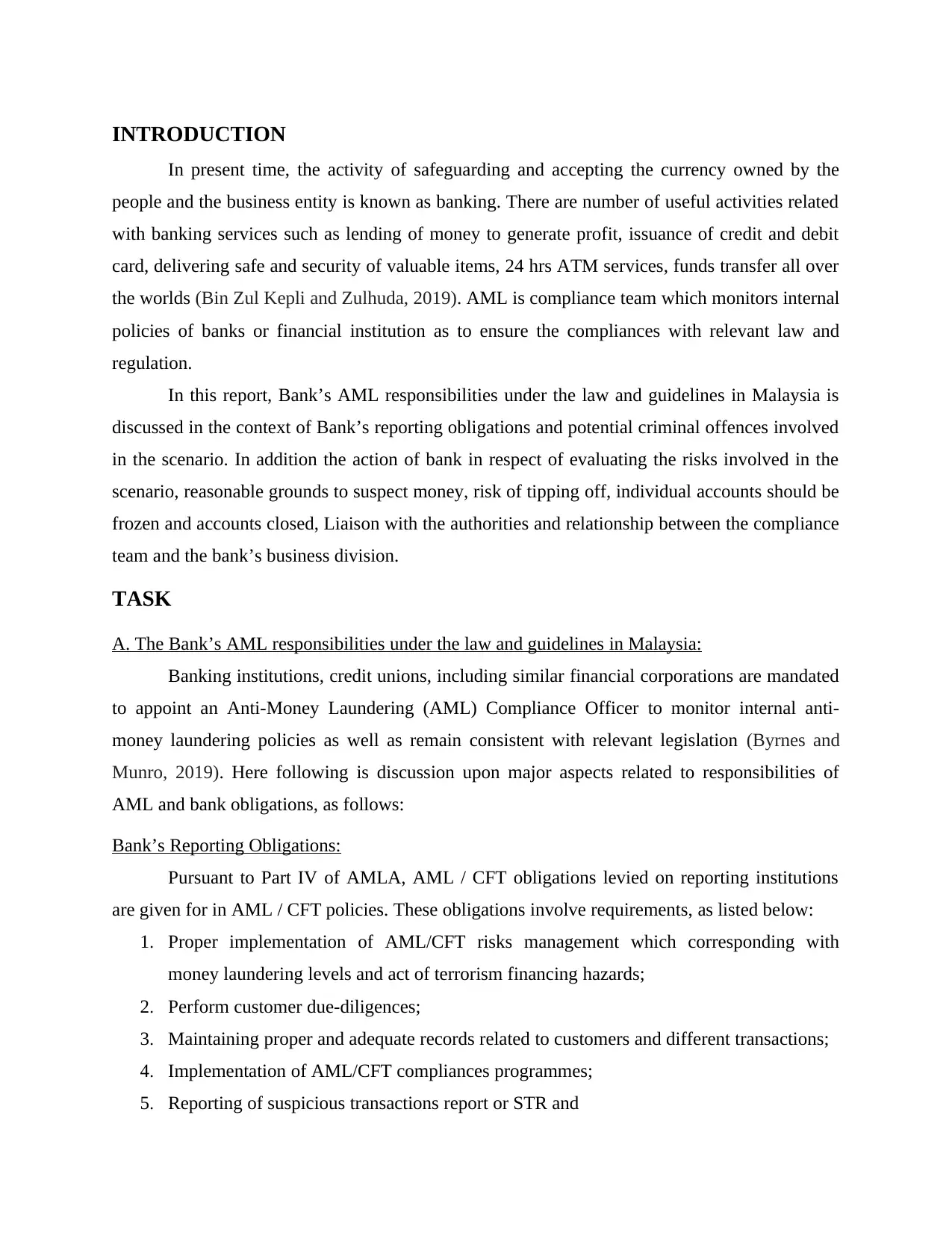
INTRODUCTION
In present time, the activity of safeguarding and accepting the currency owned by the
people and the business entity is known as banking. There are number of useful activities related
with banking services such as lending of money to generate profit, issuance of credit and debit
card, delivering safe and security of valuable items, 24 hrs ATM services, funds transfer all over
the worlds (Bin Zul Kepli and Zulhuda, 2019). AML is compliance team which monitors internal
policies of banks or financial institution as to ensure the compliances with relevant law and
regulation.
In this report, Bank’s AML responsibilities under the law and guidelines in Malaysia is
discussed in the context of Bank’s reporting obligations and potential criminal offences involved
in the scenario. In addition the action of bank in respect of evaluating the risks involved in the
scenario, reasonable grounds to suspect money, risk of tipping off, individual accounts should be
frozen and accounts closed, Liaison with the authorities and relationship between the compliance
team and the bank’s business division.
TASK
A. The Bank’s AML responsibilities under the law and guidelines in Malaysia:
Banking institutions, credit unions, including similar financial corporations are mandated
to appoint an Anti-Money Laundering (AML) Compliance Officer to monitor internal anti-
money laundering policies as well as remain consistent with relevant legislation (Byrnes and
Munro, 2019). Here following is discussion upon major aspects related to responsibilities of
AML and bank obligations, as follows:
Bank’s Reporting Obligations:
Pursuant to Part IV of AMLA, AML / CFT obligations levied on reporting institutions
are given for in AML / CFT policies. These obligations involve requirements, as listed below:
1. Proper implementation of AML/CFT risks management which corresponding with
money laundering levels and act of terrorism financing hazards;
2. Perform customer due-diligences;
3. Maintaining proper and adequate records related to customers and different transactions;
4. Implementation of AML/CFT compliances programmes;
5. Reporting of suspicious transactions report or STR and
In present time, the activity of safeguarding and accepting the currency owned by the
people and the business entity is known as banking. There are number of useful activities related
with banking services such as lending of money to generate profit, issuance of credit and debit
card, delivering safe and security of valuable items, 24 hrs ATM services, funds transfer all over
the worlds (Bin Zul Kepli and Zulhuda, 2019). AML is compliance team which monitors internal
policies of banks or financial institution as to ensure the compliances with relevant law and
regulation.
In this report, Bank’s AML responsibilities under the law and guidelines in Malaysia is
discussed in the context of Bank’s reporting obligations and potential criminal offences involved
in the scenario. In addition the action of bank in respect of evaluating the risks involved in the
scenario, reasonable grounds to suspect money, risk of tipping off, individual accounts should be
frozen and accounts closed, Liaison with the authorities and relationship between the compliance
team and the bank’s business division.
TASK
A. The Bank’s AML responsibilities under the law and guidelines in Malaysia:
Banking institutions, credit unions, including similar financial corporations are mandated
to appoint an Anti-Money Laundering (AML) Compliance Officer to monitor internal anti-
money laundering policies as well as remain consistent with relevant legislation (Byrnes and
Munro, 2019). Here following is discussion upon major aspects related to responsibilities of
AML and bank obligations, as follows:
Bank’s Reporting Obligations:
Pursuant to Part IV of AMLA, AML / CFT obligations levied on reporting institutions
are given for in AML / CFT policies. These obligations involve requirements, as listed below:
1. Proper implementation of AML/CFT risks management which corresponding with
money laundering levels and act of terrorism financing hazards;
2. Perform customer due-diligences;
3. Maintaining proper and adequate records related to customers and different transactions;
4. Implementation of AML/CFT compliances programmes;
5. Reporting of suspicious transactions report or STR and
⊘ This is a preview!⊘
Do you want full access?
Subscribe today to unlock all pages.

Trusted by 1+ million students worldwide
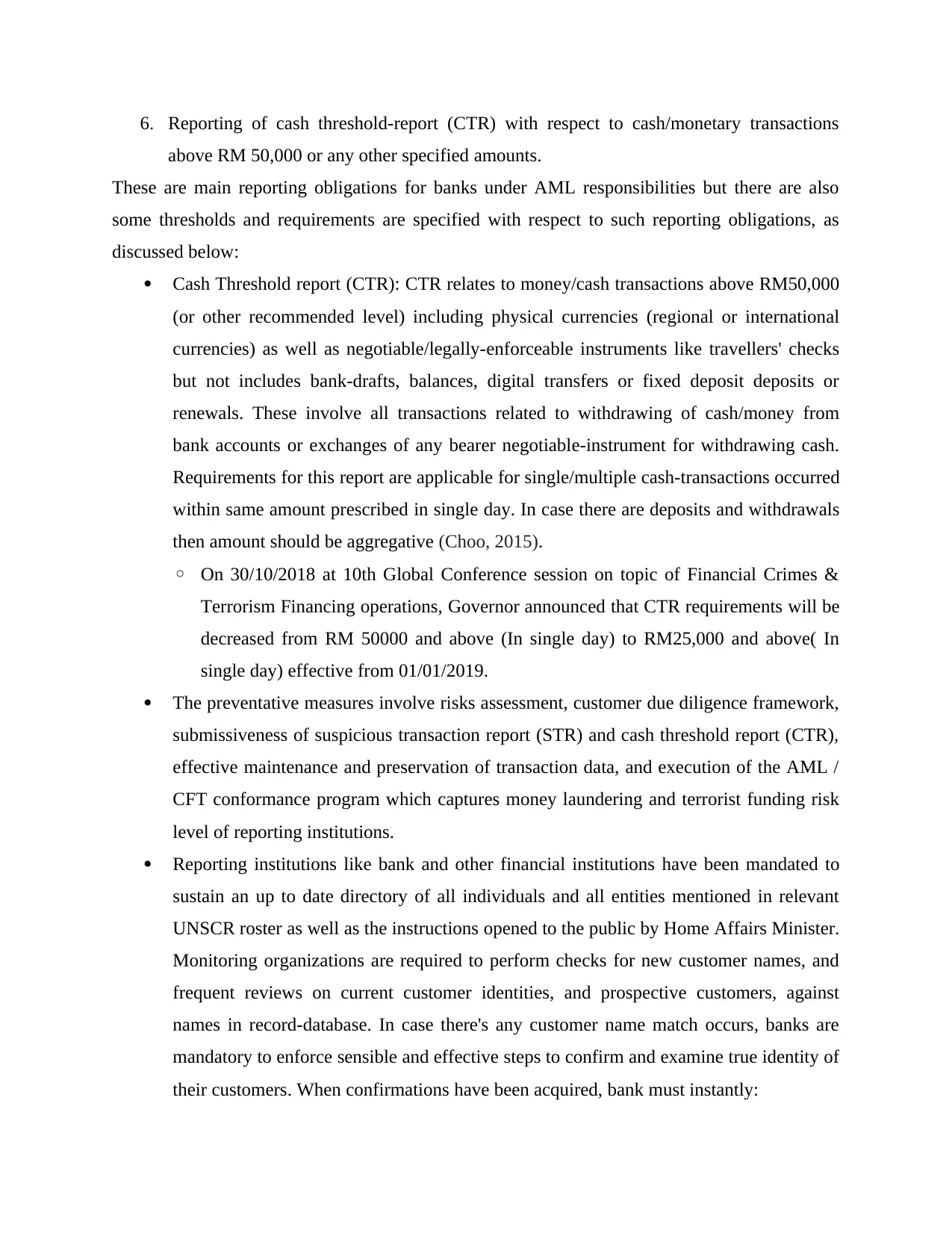
6. Reporting of cash threshold-report (CTR) with respect to cash/monetary transactions
above RM 50,000 or any other specified amounts.
These are main reporting obligations for banks under AML responsibilities but there are also
some thresholds and requirements are specified with respect to such reporting obligations, as
discussed below:
Cash Threshold report (CTR): CTR relates to money/cash transactions above RM50,000
(or other recommended level) including physical currencies (regional or international
currencies) as well as negotiable/legally-enforceable instruments like travellers' checks
but not includes bank-drafts, balances, digital transfers or fixed deposit deposits or
renewals. These involve all transactions related to withdrawing of cash/money from
bank accounts or exchanges of any bearer negotiable-instrument for withdrawing cash.
Requirements for this report are applicable for single/multiple cash-transactions occurred
within same amount prescribed in single day. In case there are deposits and withdrawals
then amount should be aggregative (Choo, 2015).
◦ On 30/10/2018 at 10th Global Conference session on topic of Financial Crimes &
Terrorism Financing operations, Governor announced that CTR requirements will be
decreased from RM 50000 and above (In single day) to RM25,000 and above( In
single day) effective from 01/01/2019.
The preventative measures involve risks assessment, customer due diligence framework,
submissiveness of suspicious transaction report (STR) and cash threshold report (CTR),
effective maintenance and preservation of transaction data, and execution of the AML /
CFT conformance program which captures money laundering and terrorist funding risk
level of reporting institutions.
Reporting institutions like bank and other financial institutions have been mandated to
sustain an up to date directory of all individuals and all entities mentioned in relevant
UNSCR roster as well as the instructions opened to the public by Home Affairs Minister.
Monitoring organizations are required to perform checks for new customer names, and
frequent reviews on current customer identities, and prospective customers, against
names in record-database. In case there's any customer name match occurs, banks are
mandatory to enforce sensible and effective steps to confirm and examine true identity of
their customers. When confirmations have been acquired, bank must instantly:
above RM 50,000 or any other specified amounts.
These are main reporting obligations for banks under AML responsibilities but there are also
some thresholds and requirements are specified with respect to such reporting obligations, as
discussed below:
Cash Threshold report (CTR): CTR relates to money/cash transactions above RM50,000
(or other recommended level) including physical currencies (regional or international
currencies) as well as negotiable/legally-enforceable instruments like travellers' checks
but not includes bank-drafts, balances, digital transfers or fixed deposit deposits or
renewals. These involve all transactions related to withdrawing of cash/money from
bank accounts or exchanges of any bearer negotiable-instrument for withdrawing cash.
Requirements for this report are applicable for single/multiple cash-transactions occurred
within same amount prescribed in single day. In case there are deposits and withdrawals
then amount should be aggregative (Choo, 2015).
◦ On 30/10/2018 at 10th Global Conference session on topic of Financial Crimes &
Terrorism Financing operations, Governor announced that CTR requirements will be
decreased from RM 50000 and above (In single day) to RM25,000 and above( In
single day) effective from 01/01/2019.
The preventative measures involve risks assessment, customer due diligence framework,
submissiveness of suspicious transaction report (STR) and cash threshold report (CTR),
effective maintenance and preservation of transaction data, and execution of the AML /
CFT conformance program which captures money laundering and terrorist funding risk
level of reporting institutions.
Reporting institutions like bank and other financial institutions have been mandated to
sustain an up to date directory of all individuals and all entities mentioned in relevant
UNSCR roster as well as the instructions opened to the public by Home Affairs Minister.
Monitoring organizations are required to perform checks for new customer names, and
frequent reviews on current customer identities, and prospective customers, against
names in record-database. In case there's any customer name match occurs, banks are
mandatory to enforce sensible and effective steps to confirm and examine true identity of
their customers. When confirmations have been acquired, bank must instantly:
Paraphrase This Document
Need a fresh take? Get an instant paraphrase of this document with our AI Paraphraser
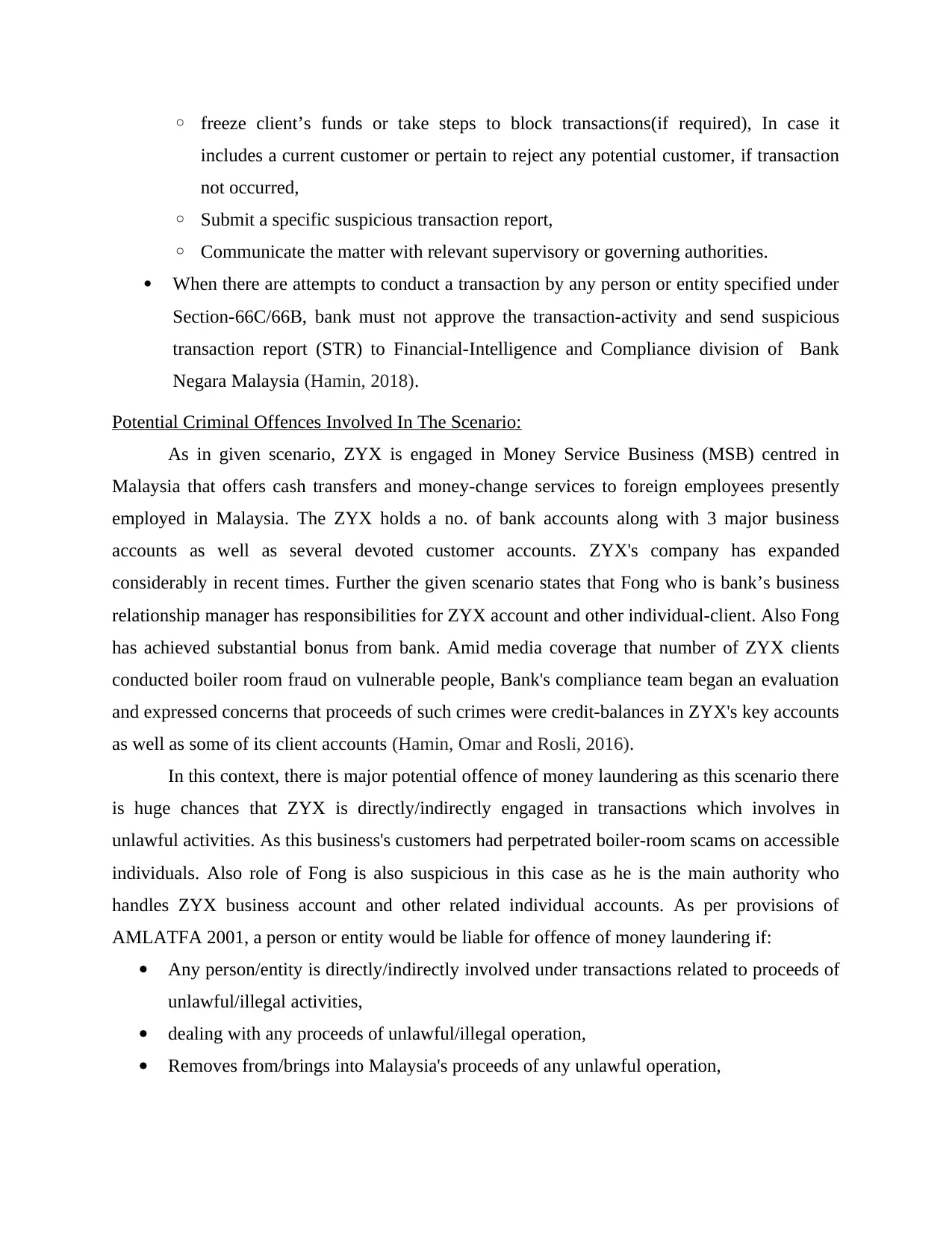
◦ freeze client’s funds or take steps to block transactions(if required), In case it
includes a current customer or pertain to reject any potential customer, if transaction
not occurred,
◦ Submit a specific suspicious transaction report,
◦ Communicate the matter with relevant supervisory or governing authorities.
When there are attempts to conduct a transaction by any person or entity specified under
Section-66C/66B, bank must not approve the transaction-activity and send suspicious
transaction report (STR) to Financial-Intelligence and Compliance division of Bank
Negara Malaysia (Hamin, 2018).
Potential Criminal Offences Involved In The Scenario:
As in given scenario, ZYX is engaged in Money Service Business (MSB) centred in
Malaysia that offers cash transfers and money-change services to foreign employees presently
employed in Malaysia. The ZYX holds a no. of bank accounts along with 3 major business
accounts as well as several devoted customer accounts. ZYX's company has expanded
considerably in recent times. Further the given scenario states that Fong who is bank’s business
relationship manager has responsibilities for ZYX account and other individual-client. Also Fong
has achieved substantial bonus from bank. Amid media coverage that number of ZYX clients
conducted boiler room fraud on vulnerable people, Bank's compliance team began an evaluation
and expressed concerns that proceeds of such crimes were credit-balances in ZYX's key accounts
as well as some of its client accounts (Hamin, Omar and Rosli, 2016).
In this context, there is major potential offence of money laundering as this scenario there
is huge chances that ZYX is directly/indirectly engaged in transactions which involves in
unlawful activities. As this business's customers had perpetrated boiler-room scams on accessible
individuals. Also role of Fong is also suspicious in this case as he is the main authority who
handles ZYX business account and other related individual accounts. As per provisions of
AMLATFA 2001, a person or entity would be liable for offence of money laundering if:
Any person/entity is directly/indirectly involved under transactions related to proceeds of
unlawful/illegal activities,
dealing with any proceeds of unlawful/illegal operation,
Removes from/brings into Malaysia's proceeds of any unlawful operation,
includes a current customer or pertain to reject any potential customer, if transaction
not occurred,
◦ Submit a specific suspicious transaction report,
◦ Communicate the matter with relevant supervisory or governing authorities.
When there are attempts to conduct a transaction by any person or entity specified under
Section-66C/66B, bank must not approve the transaction-activity and send suspicious
transaction report (STR) to Financial-Intelligence and Compliance division of Bank
Negara Malaysia (Hamin, 2018).
Potential Criminal Offences Involved In The Scenario:
As in given scenario, ZYX is engaged in Money Service Business (MSB) centred in
Malaysia that offers cash transfers and money-change services to foreign employees presently
employed in Malaysia. The ZYX holds a no. of bank accounts along with 3 major business
accounts as well as several devoted customer accounts. ZYX's company has expanded
considerably in recent times. Further the given scenario states that Fong who is bank’s business
relationship manager has responsibilities for ZYX account and other individual-client. Also Fong
has achieved substantial bonus from bank. Amid media coverage that number of ZYX clients
conducted boiler room fraud on vulnerable people, Bank's compliance team began an evaluation
and expressed concerns that proceeds of such crimes were credit-balances in ZYX's key accounts
as well as some of its client accounts (Hamin, Omar and Rosli, 2016).
In this context, there is major potential offence of money laundering as this scenario there
is huge chances that ZYX is directly/indirectly engaged in transactions which involves in
unlawful activities. As this business's customers had perpetrated boiler-room scams on accessible
individuals. Also role of Fong is also suspicious in this case as he is the main authority who
handles ZYX business account and other related individual accounts. As per provisions of
AMLATFA 2001, a person or entity would be liable for offence of money laundering if:
Any person/entity is directly/indirectly involved under transactions related to proceeds of
unlawful/illegal activities,
dealing with any proceeds of unlawful/illegal operation,
Removes from/brings into Malaysia's proceeds of any unlawful operation,
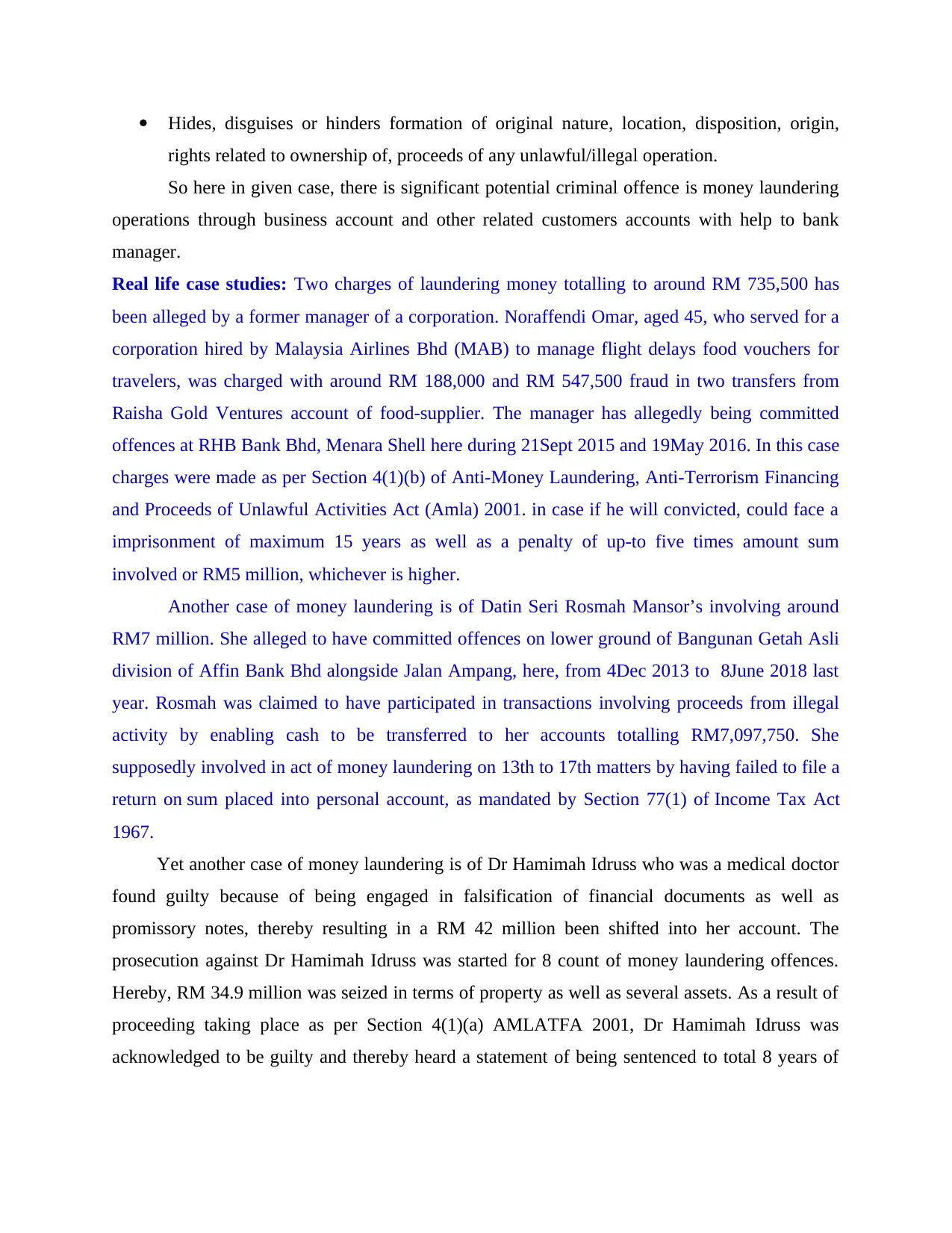
Hides, disguises or hinders formation of original nature, location, disposition, origin,
rights related to ownership of, proceeds of any unlawful/illegal operation.
So here in given case, there is significant potential criminal offence is money laundering
operations through business account and other related customers accounts with help to bank
manager.
Real life case studies: Two charges of laundering money totalling to around RM 735,500 has
been alleged by a former manager of a corporation. Noraffendi Omar, aged 45, who served for a
corporation hired by Malaysia Airlines Bhd (MAB) to manage flight delays food vouchers for
travelers, was charged with around RM 188,000 and RM 547,500 fraud in two transfers from
Raisha Gold Ventures account of food-supplier. The manager has allegedly being committed
offences at RHB Bank Bhd, Menara Shell here during 21Sept 2015 and 19May 2016. In this case
charges were made as per Section 4(1)(b) of Anti-Money Laundering, Anti-Terrorism Financing
and Proceeds of Unlawful Activities Act (Amla) 2001. in case if he will convicted, could face a
imprisonment of maximum 15 years as well as a penalty of up-to five times amount sum
involved or RM5 million, whichever is higher.
Another case of money laundering is of Datin Seri Rosmah Mansor’s involving around
RM7 million. She alleged to have committed offences on lower ground of Bangunan Getah Asli
division of Affin Bank Bhd alongside Jalan Ampang, here, from 4Dec 2013 to 8June 2018 last
year. Rosmah was claimed to have participated in transactions involving proceeds from illegal
activity by enabling cash to be transferred to her accounts totalling RM7,097,750. She
supposedly involved in act of money laundering on 13th to 17th matters by having failed to file a
return on sum placed into personal account, as mandated by Section 77(1) of Income Tax Act
1967.
Yet another case of money laundering is of Dr Hamimah Idruss who was a medical doctor
found guilty because of being engaged in falsification of financial documents as well as
promissory notes, thereby resulting in a RM 42 million been shifted into her account. The
prosecution against Dr Hamimah Idruss was started for 8 count of money laundering offences.
Hereby, RM 34.9 million was seized in terms of property as well as several assets. As a result of
proceeding taking place as per Section 4(1)(a) AMLATFA 2001, Dr Hamimah Idruss was
acknowledged to be guilty and thereby heard a statement of being sentenced to total 8 years of
rights related to ownership of, proceeds of any unlawful/illegal operation.
So here in given case, there is significant potential criminal offence is money laundering
operations through business account and other related customers accounts with help to bank
manager.
Real life case studies: Two charges of laundering money totalling to around RM 735,500 has
been alleged by a former manager of a corporation. Noraffendi Omar, aged 45, who served for a
corporation hired by Malaysia Airlines Bhd (MAB) to manage flight delays food vouchers for
travelers, was charged with around RM 188,000 and RM 547,500 fraud in two transfers from
Raisha Gold Ventures account of food-supplier. The manager has allegedly being committed
offences at RHB Bank Bhd, Menara Shell here during 21Sept 2015 and 19May 2016. In this case
charges were made as per Section 4(1)(b) of Anti-Money Laundering, Anti-Terrorism Financing
and Proceeds of Unlawful Activities Act (Amla) 2001. in case if he will convicted, could face a
imprisonment of maximum 15 years as well as a penalty of up-to five times amount sum
involved or RM5 million, whichever is higher.
Another case of money laundering is of Datin Seri Rosmah Mansor’s involving around
RM7 million. She alleged to have committed offences on lower ground of Bangunan Getah Asli
division of Affin Bank Bhd alongside Jalan Ampang, here, from 4Dec 2013 to 8June 2018 last
year. Rosmah was claimed to have participated in transactions involving proceeds from illegal
activity by enabling cash to be transferred to her accounts totalling RM7,097,750. She
supposedly involved in act of money laundering on 13th to 17th matters by having failed to file a
return on sum placed into personal account, as mandated by Section 77(1) of Income Tax Act
1967.
Yet another case of money laundering is of Dr Hamimah Idruss who was a medical doctor
found guilty because of being engaged in falsification of financial documents as well as
promissory notes, thereby resulting in a RM 42 million been shifted into her account. The
prosecution against Dr Hamimah Idruss was started for 8 count of money laundering offences.
Hereby, RM 34.9 million was seized in terms of property as well as several assets. As a result of
proceeding taking place as per Section 4(1)(a) AMLATFA 2001, Dr Hamimah Idruss was
acknowledged to be guilty and thereby heard a statement of being sentenced to total 8 years of
⊘ This is a preview!⊘
Do you want full access?
Subscribe today to unlock all pages.

Trusted by 1+ million students worldwide
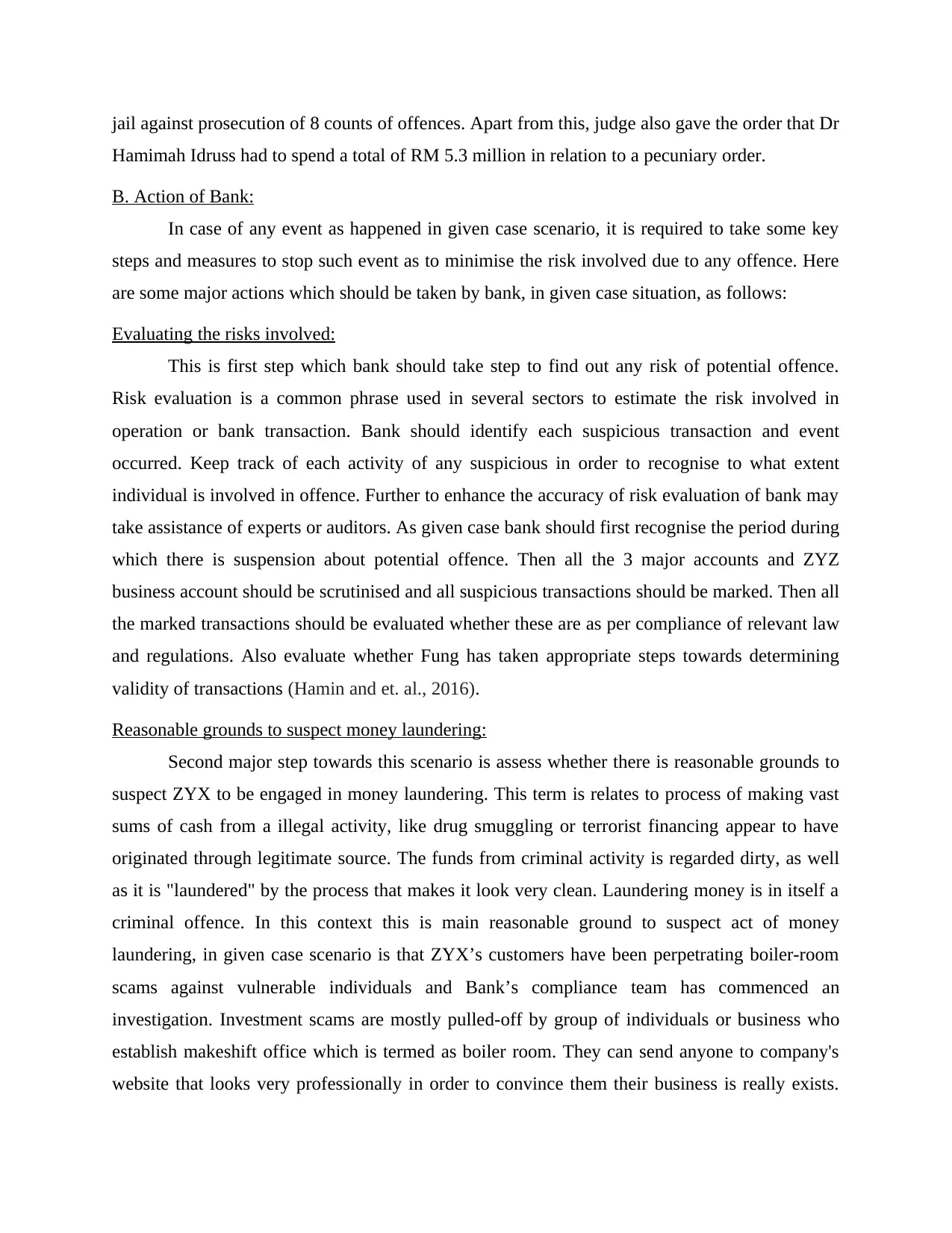
jail against prosecution of 8 counts of offences. Apart from this, judge also gave the order that Dr
Hamimah Idruss had to spend a total of RM 5.3 million in relation to a pecuniary order.
B. Action of Bank:
In case of any event as happened in given case scenario, it is required to take some key
steps and measures to stop such event as to minimise the risk involved due to any offence. Here
are some major actions which should be taken by bank, in given case situation, as follows:
Evaluating the risks involved:
This is first step which bank should take step to find out any risk of potential offence.
Risk evaluation is a common phrase used in several sectors to estimate the risk involved in
operation or bank transaction. Bank should identify each suspicious transaction and event
occurred. Keep track of each activity of any suspicious in order to recognise to what extent
individual is involved in offence. Further to enhance the accuracy of risk evaluation of bank may
take assistance of experts or auditors. As given case bank should first recognise the period during
which there is suspension about potential offence. Then all the 3 major accounts and ZYZ
business account should be scrutinised and all suspicious transactions should be marked. Then all
the marked transactions should be evaluated whether these are as per compliance of relevant law
and regulations. Also evaluate whether Fung has taken appropriate steps towards determining
validity of transactions (Hamin and et. al., 2016).
Reasonable grounds to suspect money laundering:
Second major step towards this scenario is assess whether there is reasonable grounds to
suspect ZYX to be engaged in money laundering. This term is relates to process of making vast
sums of cash from a illegal activity, like drug smuggling or terrorist financing appear to have
originated through legitimate source. The funds from criminal activity is regarded dirty, as well
as it is "laundered" by the process that makes it look very clean. Laundering money is in itself a
criminal offence. In this context this is main reasonable ground to suspect act of money
laundering, in given case scenario is that ZYX’s customers have been perpetrating boiler-room
scams against vulnerable individuals and Bank’s compliance team has commenced an
investigation. Investment scams are mostly pulled-off by group of individuals or business who
establish makeshift office which is termed as boiler room. They can send anyone to company's
website that looks very professionally in order to convince them their business is really exists.
Hamimah Idruss had to spend a total of RM 5.3 million in relation to a pecuniary order.
B. Action of Bank:
In case of any event as happened in given case scenario, it is required to take some key
steps and measures to stop such event as to minimise the risk involved due to any offence. Here
are some major actions which should be taken by bank, in given case situation, as follows:
Evaluating the risks involved:
This is first step which bank should take step to find out any risk of potential offence.
Risk evaluation is a common phrase used in several sectors to estimate the risk involved in
operation or bank transaction. Bank should identify each suspicious transaction and event
occurred. Keep track of each activity of any suspicious in order to recognise to what extent
individual is involved in offence. Further to enhance the accuracy of risk evaluation of bank may
take assistance of experts or auditors. As given case bank should first recognise the period during
which there is suspension about potential offence. Then all the 3 major accounts and ZYZ
business account should be scrutinised and all suspicious transactions should be marked. Then all
the marked transactions should be evaluated whether these are as per compliance of relevant law
and regulations. Also evaluate whether Fung has taken appropriate steps towards determining
validity of transactions (Hamin and et. al., 2016).
Reasonable grounds to suspect money laundering:
Second major step towards this scenario is assess whether there is reasonable grounds to
suspect ZYX to be engaged in money laundering. This term is relates to process of making vast
sums of cash from a illegal activity, like drug smuggling or terrorist financing appear to have
originated through legitimate source. The funds from criminal activity is regarded dirty, as well
as it is "laundered" by the process that makes it look very clean. Laundering money is in itself a
criminal offence. In this context this is main reasonable ground to suspect act of money
laundering, in given case scenario is that ZYX’s customers have been perpetrating boiler-room
scams against vulnerable individuals and Bank’s compliance team has commenced an
investigation. Investment scams are mostly pulled-off by group of individuals or business who
establish makeshift office which is termed as boiler room. They can send anyone to company's
website that looks very professionally in order to convince them their business is really exists.
Paraphrase This Document
Need a fresh take? Get an instant paraphrase of this document with our AI Paraphraser
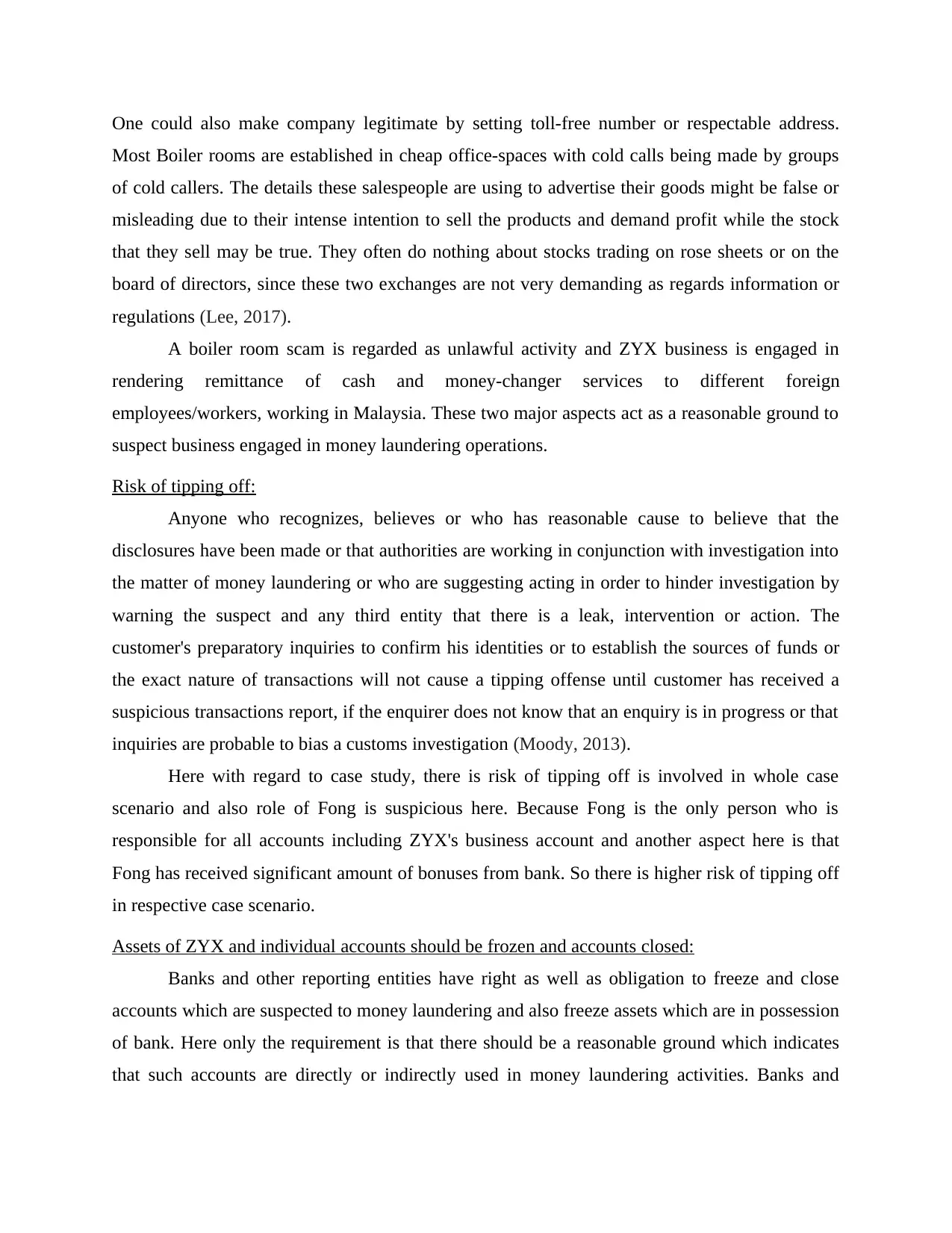
One could also make company legitimate by setting toll-free number or respectable address.
Most Boiler rooms are established in cheap office-spaces with cold calls being made by groups
of cold callers. The details these salespeople are using to advertise their goods might be false or
misleading due to their intense intention to sell the products and demand profit while the stock
that they sell may be true. They often do nothing about stocks trading on rose sheets or on the
board of directors, since these two exchanges are not very demanding as regards information or
regulations (Lee, 2017).
A boiler room scam is regarded as unlawful activity and ZYX business is engaged in
rendering remittance of cash and money-changer services to different foreign
employees/workers, working in Malaysia. These two major aspects act as a reasonable ground to
suspect business engaged in money laundering operations.
Risk of tipping off:
Anyone who recognizes, believes or who has reasonable cause to believe that the
disclosures have been made or that authorities are working in conjunction with investigation into
the matter of money laundering or who are suggesting acting in order to hinder investigation by
warning the suspect and any third entity that there is a leak, intervention or action. The
customer's preparatory inquiries to confirm his identities or to establish the sources of funds or
the exact nature of transactions will not cause a tipping offense until customer has received a
suspicious transactions report, if the enquirer does not know that an enquiry is in progress or that
inquiries are probable to bias a customs investigation (Moody, 2013).
Here with regard to case study, there is risk of tipping off is involved in whole case
scenario and also role of Fong is suspicious here. Because Fong is the only person who is
responsible for all accounts including ZYX's business account and another aspect here is that
Fong has received significant amount of bonuses from bank. So there is higher risk of tipping off
in respective case scenario.
Assets of ZYX and individual accounts should be frozen and accounts closed:
Banks and other reporting entities have right as well as obligation to freeze and close
accounts which are suspected to money laundering and also freeze assets which are in possession
of bank. Here only the requirement is that there should be a reasonable ground which indicates
that such accounts are directly or indirectly used in money laundering activities. Banks and
Most Boiler rooms are established in cheap office-spaces with cold calls being made by groups
of cold callers. The details these salespeople are using to advertise their goods might be false or
misleading due to their intense intention to sell the products and demand profit while the stock
that they sell may be true. They often do nothing about stocks trading on rose sheets or on the
board of directors, since these two exchanges are not very demanding as regards information or
regulations (Lee, 2017).
A boiler room scam is regarded as unlawful activity and ZYX business is engaged in
rendering remittance of cash and money-changer services to different foreign
employees/workers, working in Malaysia. These two major aspects act as a reasonable ground to
suspect business engaged in money laundering operations.
Risk of tipping off:
Anyone who recognizes, believes or who has reasonable cause to believe that the
disclosures have been made or that authorities are working in conjunction with investigation into
the matter of money laundering or who are suggesting acting in order to hinder investigation by
warning the suspect and any third entity that there is a leak, intervention or action. The
customer's preparatory inquiries to confirm his identities or to establish the sources of funds or
the exact nature of transactions will not cause a tipping offense until customer has received a
suspicious transactions report, if the enquirer does not know that an enquiry is in progress or that
inquiries are probable to bias a customs investigation (Moody, 2013).
Here with regard to case study, there is risk of tipping off is involved in whole case
scenario and also role of Fong is suspicious here. Because Fong is the only person who is
responsible for all accounts including ZYX's business account and another aspect here is that
Fong has received significant amount of bonuses from bank. So there is higher risk of tipping off
in respective case scenario.
Assets of ZYX and individual accounts should be frozen and accounts closed:
Banks and other reporting entities have right as well as obligation to freeze and close
accounts which are suspected to money laundering and also freeze assets which are in possession
of bank. Here only the requirement is that there should be a reasonable ground which indicates
that such accounts are directly or indirectly used in money laundering activities. Banks and
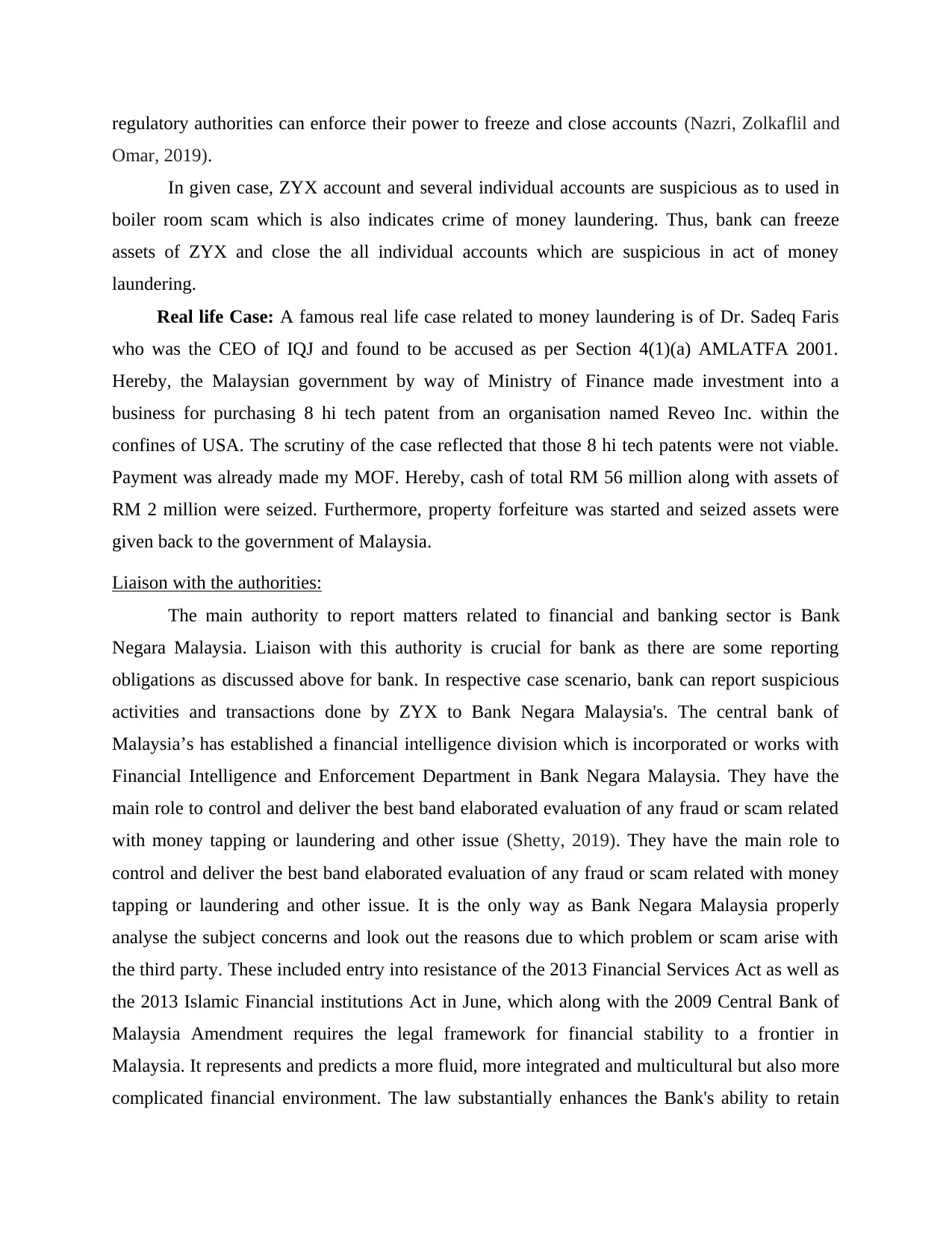
regulatory authorities can enforce their power to freeze and close accounts (Nazri, Zolkaflil and
Omar, 2019).
In given case, ZYX account and several individual accounts are suspicious as to used in
boiler room scam which is also indicates crime of money laundering. Thus, bank can freeze
assets of ZYX and close the all individual accounts which are suspicious in act of money
laundering.
Real life Case: A famous real life case related to money laundering is of Dr. Sadeq Faris
who was the CEO of IQJ and found to be accused as per Section 4(1)(a) AMLATFA 2001.
Hereby, the Malaysian government by way of Ministry of Finance made investment into a
business for purchasing 8 hi tech patent from an organisation named Reveo Inc. within the
confines of USA. The scrutiny of the case reflected that those 8 hi tech patents were not viable.
Payment was already made my MOF. Hereby, cash of total RM 56 million along with assets of
RM 2 million were seized. Furthermore, property forfeiture was started and seized assets were
given back to the government of Malaysia.
Liaison with the authorities:
The main authority to report matters related to financial and banking sector is Bank
Negara Malaysia. Liaison with this authority is crucial for bank as there are some reporting
obligations as discussed above for bank. In respective case scenario, bank can report suspicious
activities and transactions done by ZYX to Bank Negara Malaysia's. The central bank of
Malaysia’s has established a financial intelligence division which is incorporated or works with
Financial Intelligence and Enforcement Department in Bank Negara Malaysia. They have the
main role to control and deliver the best band elaborated evaluation of any fraud or scam related
with money tapping or laundering and other issue (Shetty, 2019). They have the main role to
control and deliver the best band elaborated evaluation of any fraud or scam related with money
tapping or laundering and other issue. It is the only way as Bank Negara Malaysia properly
analyse the subject concerns and look out the reasons due to which problem or scam arise with
the third party. These included entry into resistance of the 2013 Financial Services Act as well as
the 2013 Islamic Financial institutions Act in June, which along with the 2009 Central Bank of
Malaysia Amendment requires the legal framework for financial stability to a frontier in
Malaysia. It represents and predicts a more fluid, more integrated and multicultural but also more
complicated financial environment. The law substantially enhances the Bank's ability to retain
Omar, 2019).
In given case, ZYX account and several individual accounts are suspicious as to used in
boiler room scam which is also indicates crime of money laundering. Thus, bank can freeze
assets of ZYX and close the all individual accounts which are suspicious in act of money
laundering.
Real life Case: A famous real life case related to money laundering is of Dr. Sadeq Faris
who was the CEO of IQJ and found to be accused as per Section 4(1)(a) AMLATFA 2001.
Hereby, the Malaysian government by way of Ministry of Finance made investment into a
business for purchasing 8 hi tech patent from an organisation named Reveo Inc. within the
confines of USA. The scrutiny of the case reflected that those 8 hi tech patents were not viable.
Payment was already made my MOF. Hereby, cash of total RM 56 million along with assets of
RM 2 million were seized. Furthermore, property forfeiture was started and seized assets were
given back to the government of Malaysia.
Liaison with the authorities:
The main authority to report matters related to financial and banking sector is Bank
Negara Malaysia. Liaison with this authority is crucial for bank as there are some reporting
obligations as discussed above for bank. In respective case scenario, bank can report suspicious
activities and transactions done by ZYX to Bank Negara Malaysia's. The central bank of
Malaysia’s has established a financial intelligence division which is incorporated or works with
Financial Intelligence and Enforcement Department in Bank Negara Malaysia. They have the
main role to control and deliver the best band elaborated evaluation of any fraud or scam related
with money tapping or laundering and other issue (Shetty, 2019). They have the main role to
control and deliver the best band elaborated evaluation of any fraud or scam related with money
tapping or laundering and other issue. It is the only way as Bank Negara Malaysia properly
analyse the subject concerns and look out the reasons due to which problem or scam arise with
the third party. These included entry into resistance of the 2013 Financial Services Act as well as
the 2013 Islamic Financial institutions Act in June, which along with the 2009 Central Bank of
Malaysia Amendment requires the legal framework for financial stability to a frontier in
Malaysia. It represents and predicts a more fluid, more integrated and multicultural but also more
complicated financial environment. The law substantially enhances the Bank's ability to retain
⊘ This is a preview!⊘
Do you want full access?
Subscribe today to unlock all pages.

Trusted by 1+ million students worldwide
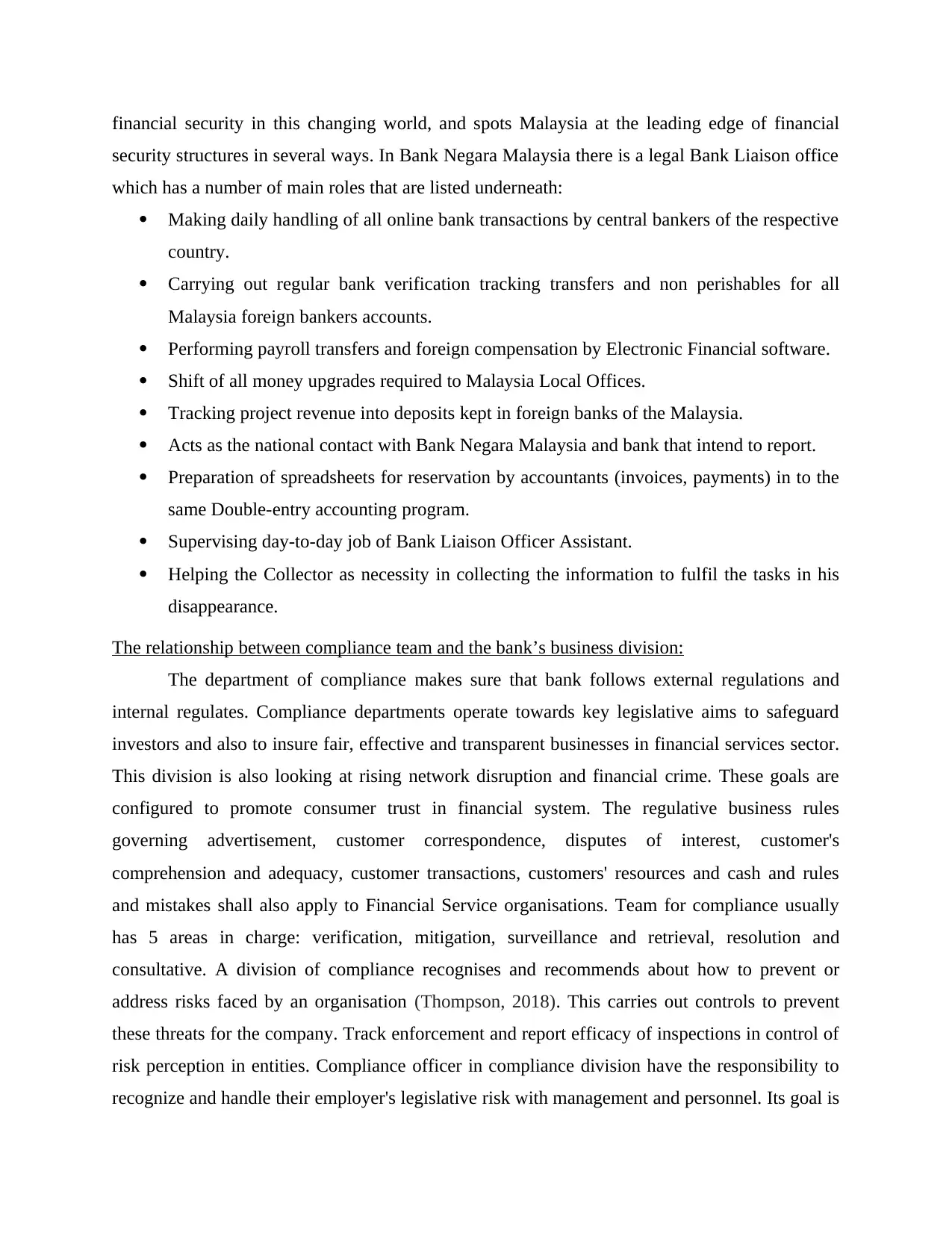
financial security in this changing world, and spots Malaysia at the leading edge of financial
security structures in several ways. In Bank Negara Malaysia there is a legal Bank Liaison office
which has a number of main roles that are listed underneath:
Making daily handling of all online bank transactions by central bankers of the respective
country.
Carrying out regular bank verification tracking transfers and non perishables for all
Malaysia foreign bankers accounts.
Performing payroll transfers and foreign compensation by Electronic Financial software.
Shift of all money upgrades required to Malaysia Local Offices.
Tracking project revenue into deposits kept in foreign banks of the Malaysia.
Acts as the national contact with Bank Negara Malaysia and bank that intend to report.
Preparation of spreadsheets for reservation by accountants (invoices, payments) in to the
same Double-entry accounting program.
Supervising day-to-day job of Bank Liaison Officer Assistant.
Helping the Collector as necessity in collecting the information to fulfil the tasks in his
disappearance.
The relationship between compliance team and the bank’s business division:
The department of compliance makes sure that bank follows external regulations and
internal regulates. Compliance departments operate towards key legislative aims to safeguard
investors and also to insure fair, effective and transparent businesses in financial services sector.
This division is also looking at rising network disruption and financial crime. These goals are
configured to promote consumer trust in financial system. The regulative business rules
governing advertisement, customer correspondence, disputes of interest, customer's
comprehension and adequacy, customer transactions, customers' resources and cash and rules
and mistakes shall also apply to Financial Service organisations. Team for compliance usually
has 5 areas in charge: verification, mitigation, surveillance and retrieval, resolution and
consultative. A division of compliance recognises and recommends about how to prevent or
address risks faced by an organisation (Thompson, 2018). This carries out controls to prevent
these threats for the company. Track enforcement and report efficacy of inspections in control of
risk perception in entities. Compliance officer in compliance division have the responsibility to
recognize and handle their employer's legislative risk with management and personnel. Its goal is
security structures in several ways. In Bank Negara Malaysia there is a legal Bank Liaison office
which has a number of main roles that are listed underneath:
Making daily handling of all online bank transactions by central bankers of the respective
country.
Carrying out regular bank verification tracking transfers and non perishables for all
Malaysia foreign bankers accounts.
Performing payroll transfers and foreign compensation by Electronic Financial software.
Shift of all money upgrades required to Malaysia Local Offices.
Tracking project revenue into deposits kept in foreign banks of the Malaysia.
Acts as the national contact with Bank Negara Malaysia and bank that intend to report.
Preparation of spreadsheets for reservation by accountants (invoices, payments) in to the
same Double-entry accounting program.
Supervising day-to-day job of Bank Liaison Officer Assistant.
Helping the Collector as necessity in collecting the information to fulfil the tasks in his
disappearance.
The relationship between compliance team and the bank’s business division:
The department of compliance makes sure that bank follows external regulations and
internal regulates. Compliance departments operate towards key legislative aims to safeguard
investors and also to insure fair, effective and transparent businesses in financial services sector.
This division is also looking at rising network disruption and financial crime. These goals are
configured to promote consumer trust in financial system. The regulative business rules
governing advertisement, customer correspondence, disputes of interest, customer's
comprehension and adequacy, customer transactions, customers' resources and cash and rules
and mistakes shall also apply to Financial Service organisations. Team for compliance usually
has 5 areas in charge: verification, mitigation, surveillance and retrieval, resolution and
consultative. A division of compliance recognises and recommends about how to prevent or
address risks faced by an organisation (Thompson, 2018). This carries out controls to prevent
these threats for the company. Track enforcement and report efficacy of inspections in control of
risk perception in entities. Compliance officer in compliance division have the responsibility to
recognize and handle their employer's legislative risk with management and personnel. Its goal is
Paraphrase This Document
Need a fresh take? Get an instant paraphrase of this document with our AI Paraphraser
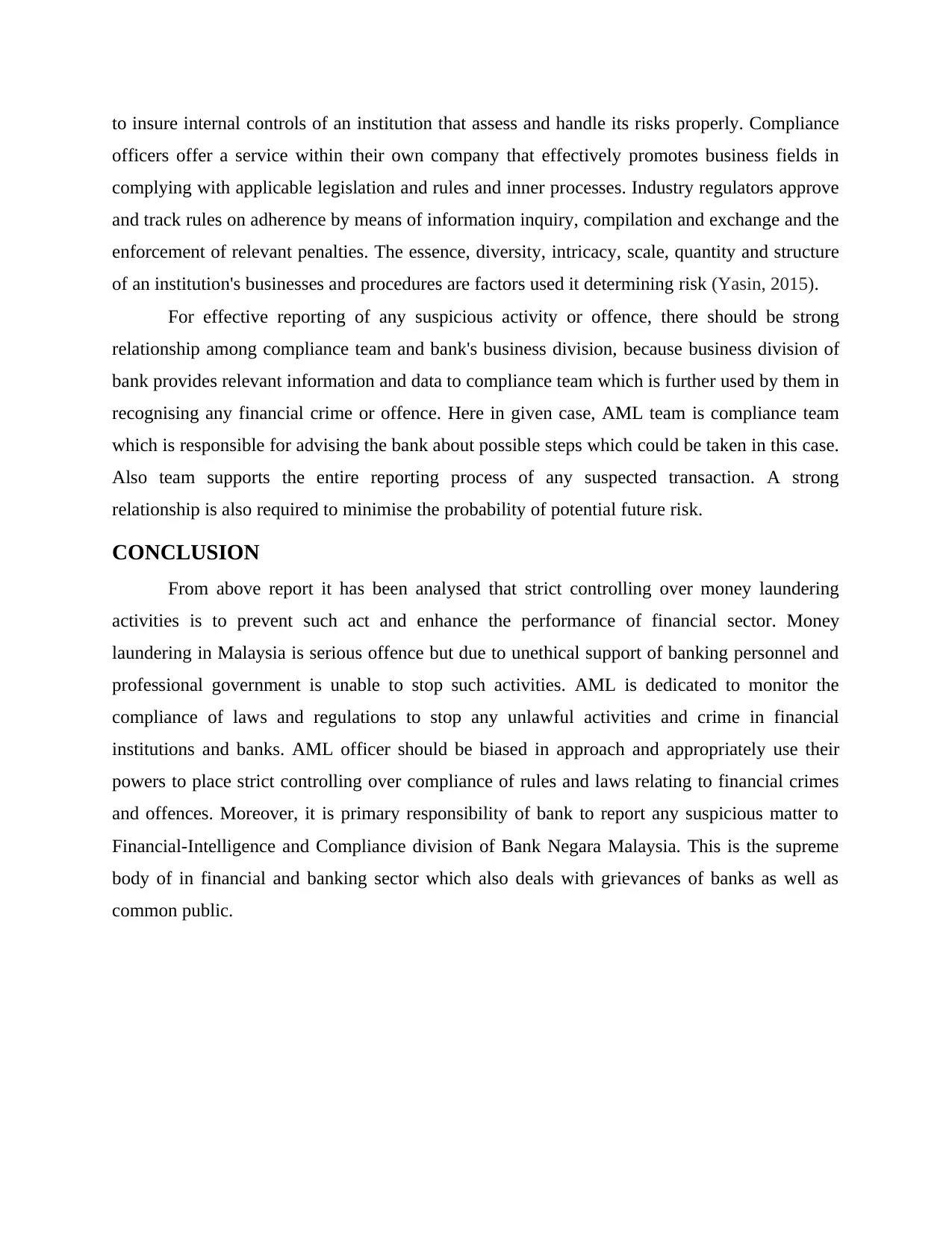
to insure internal controls of an institution that assess and handle its risks properly. Compliance
officers offer a service within their own company that effectively promotes business fields in
complying with applicable legislation and rules and inner processes. Industry regulators approve
and track rules on adherence by means of information inquiry, compilation and exchange and the
enforcement of relevant penalties. The essence, diversity, intricacy, scale, quantity and structure
of an institution's businesses and procedures are factors used it determining risk (Yasin, 2015).
For effective reporting of any suspicious activity or offence, there should be strong
relationship among compliance team and bank's business division, because business division of
bank provides relevant information and data to compliance team which is further used by them in
recognising any financial crime or offence. Here in given case, AML team is compliance team
which is responsible for advising the bank about possible steps which could be taken in this case.
Also team supports the entire reporting process of any suspected transaction. A strong
relationship is also required to minimise the probability of potential future risk.
CONCLUSION
From above report it has been analysed that strict controlling over money laundering
activities is to prevent such act and enhance the performance of financial sector. Money
laundering in Malaysia is serious offence but due to unethical support of banking personnel and
professional government is unable to stop such activities. AML is dedicated to monitor the
compliance of laws and regulations to stop any unlawful activities and crime in financial
institutions and banks. AML officer should be biased in approach and appropriately use their
powers to place strict controlling over compliance of rules and laws relating to financial crimes
and offences. Moreover, it is primary responsibility of bank to report any suspicious matter to
Financial-Intelligence and Compliance division of Bank Negara Malaysia. This is the supreme
body of in financial and banking sector which also deals with grievances of banks as well as
common public.
officers offer a service within their own company that effectively promotes business fields in
complying with applicable legislation and rules and inner processes. Industry regulators approve
and track rules on adherence by means of information inquiry, compilation and exchange and the
enforcement of relevant penalties. The essence, diversity, intricacy, scale, quantity and structure
of an institution's businesses and procedures are factors used it determining risk (Yasin, 2015).
For effective reporting of any suspicious activity or offence, there should be strong
relationship among compliance team and bank's business division, because business division of
bank provides relevant information and data to compliance team which is further used by them in
recognising any financial crime or offence. Here in given case, AML team is compliance team
which is responsible for advising the bank about possible steps which could be taken in this case.
Also team supports the entire reporting process of any suspected transaction. A strong
relationship is also required to minimise the probability of potential future risk.
CONCLUSION
From above report it has been analysed that strict controlling over money laundering
activities is to prevent such act and enhance the performance of financial sector. Money
laundering in Malaysia is serious offence but due to unethical support of banking personnel and
professional government is unable to stop such activities. AML is dedicated to monitor the
compliance of laws and regulations to stop any unlawful activities and crime in financial
institutions and banks. AML officer should be biased in approach and appropriately use their
powers to place strict controlling over compliance of rules and laws relating to financial crimes
and offences. Moreover, it is primary responsibility of bank to report any suspicious matter to
Financial-Intelligence and Compliance division of Bank Negara Malaysia. This is the supreme
body of in financial and banking sector which also deals with grievances of banks as well as
common public.
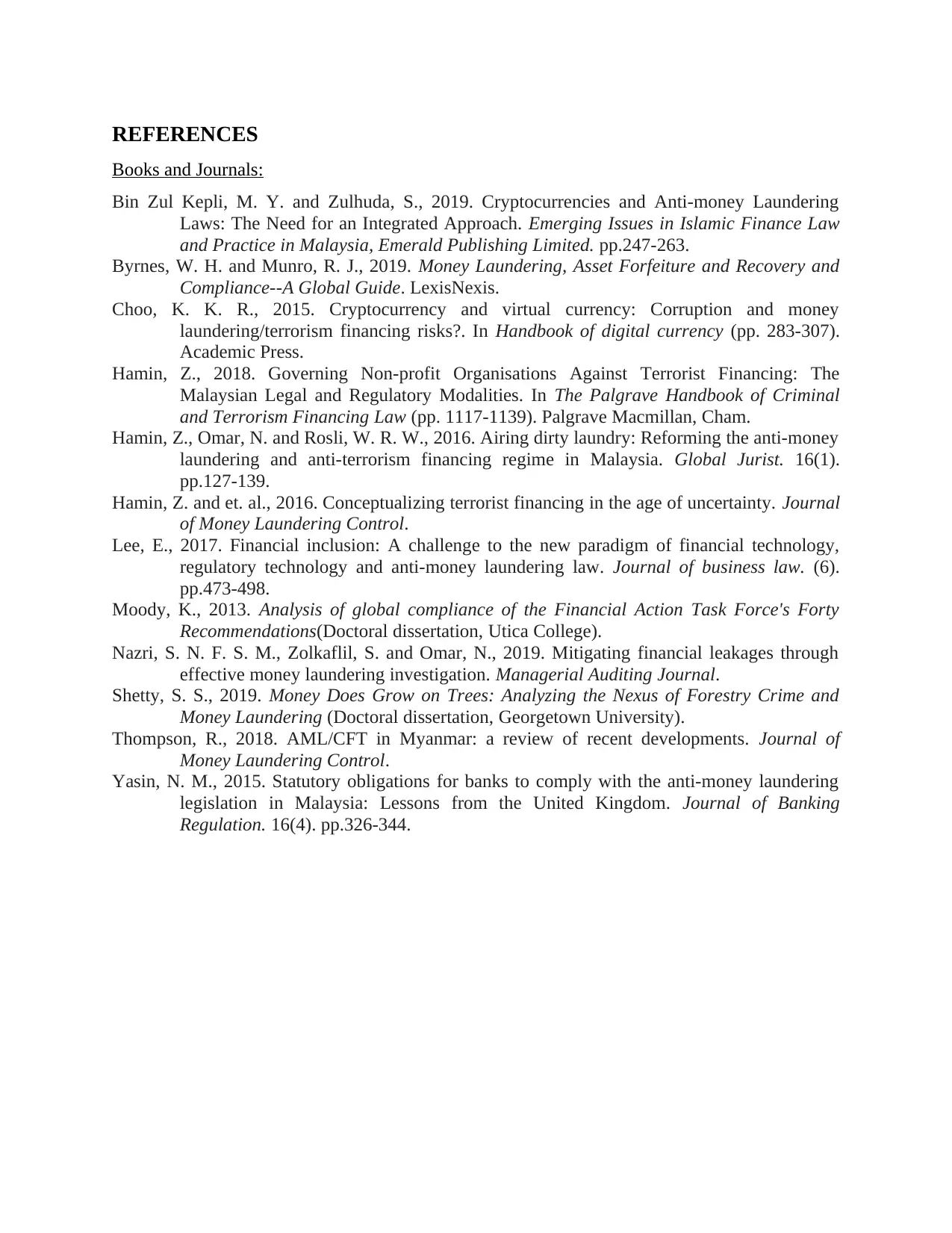
REFERENCES
Books and Journals:
Bin Zul Kepli, M. Y. and Zulhuda, S., 2019. Cryptocurrencies and Anti-money Laundering
Laws: The Need for an Integrated Approach. Emerging Issues in Islamic Finance Law
and Practice in Malaysia, Emerald Publishing Limited. pp.247-263.
Byrnes, W. H. and Munro, R. J., 2019. Money Laundering, Asset Forfeiture and Recovery and
Compliance--A Global Guide. LexisNexis.
Choo, K. K. R., 2015. Cryptocurrency and virtual currency: Corruption and money
laundering/terrorism financing risks?. In Handbook of digital currency (pp. 283-307).
Academic Press.
Hamin, Z., 2018. Governing Non-profit Organisations Against Terrorist Financing: The
Malaysian Legal and Regulatory Modalities. In The Palgrave Handbook of Criminal
and Terrorism Financing Law (pp. 1117-1139). Palgrave Macmillan, Cham.
Hamin, Z., Omar, N. and Rosli, W. R. W., 2016. Airing dirty laundry: Reforming the anti-money
laundering and anti-terrorism financing regime in Malaysia. Global Jurist. 16(1).
pp.127-139.
Hamin, Z. and et. al., 2016. Conceptualizing terrorist financing in the age of uncertainty. Journal
of Money Laundering Control.
Lee, E., 2017. Financial inclusion: A challenge to the new paradigm of financial technology,
regulatory technology and anti-money laundering law. Journal of business law. (6).
pp.473-498.
Moody, K., 2013. Analysis of global compliance of the Financial Action Task Force's Forty
Recommendations(Doctoral dissertation, Utica College).
Nazri, S. N. F. S. M., Zolkaflil, S. and Omar, N., 2019. Mitigating financial leakages through
effective money laundering investigation. Managerial Auditing Journal.
Shetty, S. S., 2019. Money Does Grow on Trees: Analyzing the Nexus of Forestry Crime and
Money Laundering (Doctoral dissertation, Georgetown University).
Thompson, R., 2018. AML/CFT in Myanmar: a review of recent developments. Journal of
Money Laundering Control.
Yasin, N. M., 2015. Statutory obligations for banks to comply with the anti-money laundering
legislation in Malaysia: Lessons from the United Kingdom. Journal of Banking
Regulation. 16(4). pp.326-344.
Books and Journals:
Bin Zul Kepli, M. Y. and Zulhuda, S., 2019. Cryptocurrencies and Anti-money Laundering
Laws: The Need for an Integrated Approach. Emerging Issues in Islamic Finance Law
and Practice in Malaysia, Emerald Publishing Limited. pp.247-263.
Byrnes, W. H. and Munro, R. J., 2019. Money Laundering, Asset Forfeiture and Recovery and
Compliance--A Global Guide. LexisNexis.
Choo, K. K. R., 2015. Cryptocurrency and virtual currency: Corruption and money
laundering/terrorism financing risks?. In Handbook of digital currency (pp. 283-307).
Academic Press.
Hamin, Z., 2018. Governing Non-profit Organisations Against Terrorist Financing: The
Malaysian Legal and Regulatory Modalities. In The Palgrave Handbook of Criminal
and Terrorism Financing Law (pp. 1117-1139). Palgrave Macmillan, Cham.
Hamin, Z., Omar, N. and Rosli, W. R. W., 2016. Airing dirty laundry: Reforming the anti-money
laundering and anti-terrorism financing regime in Malaysia. Global Jurist. 16(1).
pp.127-139.
Hamin, Z. and et. al., 2016. Conceptualizing terrorist financing in the age of uncertainty. Journal
of Money Laundering Control.
Lee, E., 2017. Financial inclusion: A challenge to the new paradigm of financial technology,
regulatory technology and anti-money laundering law. Journal of business law. (6).
pp.473-498.
Moody, K., 2013. Analysis of global compliance of the Financial Action Task Force's Forty
Recommendations(Doctoral dissertation, Utica College).
Nazri, S. N. F. S. M., Zolkaflil, S. and Omar, N., 2019. Mitigating financial leakages through
effective money laundering investigation. Managerial Auditing Journal.
Shetty, S. S., 2019. Money Does Grow on Trees: Analyzing the Nexus of Forestry Crime and
Money Laundering (Doctoral dissertation, Georgetown University).
Thompson, R., 2018. AML/CFT in Myanmar: a review of recent developments. Journal of
Money Laundering Control.
Yasin, N. M., 2015. Statutory obligations for banks to comply with the anti-money laundering
legislation in Malaysia: Lessons from the United Kingdom. Journal of Banking
Regulation. 16(4). pp.326-344.
⊘ This is a preview!⊘
Do you want full access?
Subscribe today to unlock all pages.

Trusted by 1+ million students worldwide
1 out of 12
Your All-in-One AI-Powered Toolkit for Academic Success.
+13062052269
info@desklib.com
Available 24*7 on WhatsApp / Email
![[object Object]](/_next/static/media/star-bottom.7253800d.svg)
Unlock your academic potential
Copyright © 2020–2025 A2Z Services. All Rights Reserved. Developed and managed by ZUCOL.

